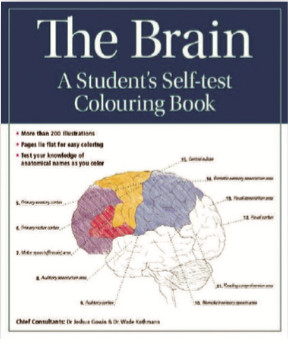I had two motives for reviewing ‘The Brain: A Student’s Self-test Colouring Book’.
Firstly, seeing well-learnt knowledge presented in a new way is useful preparation for teaching and it so happens that I have recently had to take responsibility for pre-clinical Neuroscience teaching. And secondly, I have always taken (childish) pleasure in reading encyclopaedias designed for children. The latter is generally manifested as taking a few minutes longer than strictly necessary in leafing through such volumes in book-shops when deciding on a purchase to offer as a gift to some unsuspecting young relative.
For the mature clinician or scientist of the nervous system, this book may be the literary equivalent of Lucozade. But few of us have such stamina or such sophistication of the palate that we can’t get some refreshment, or even pleasure, from an occasional sip of fizzy pop.
Unsurprisingly, there were moments when the need for a more sophisticated beverage was felt. In discussing the conduction of the action potential, the term ‘saltatory’ was said to derive from the Latin for ‘to dance’, which got me ‘jumping’. At one point, the dorsal root was mislabelled as the dorsal horn. The medial lemniscus was omitted from the section of text concerning somatosensory pathways.
For me, the biggest missed trick in terms of providing depth to the reader’s learning was the failure to distinguish either in the drawings or accompanying texts those areas that are juxtaposed largely for reasons of parallel development, from neighbouring regions that are intimately linked in function. The basal ganglia provide a good example: the caudate and putamen are both functionally part of the neostriatum but separated by the anterior limb of the internal capsule, whose constituent fibres must traverse the deep grey matter of the forebrain from the origin in the cortex to their destination in the pons and elsewhere. I understand that one has to draw a line on descriptions of function in a book about structure; I just think they drew it too soon.
For the medical neurologist, coronal and axial sections through the diencephalon and basal ganglia are perhaps less like the backs of our hands than for surgeons and radiologists. I found those pages the most useful.
All in all, this is a modest book – modestly priced and quick to leaf through. I can recommend it to my peers, especially those wishing to consolidate their Anatomy before teaching.
